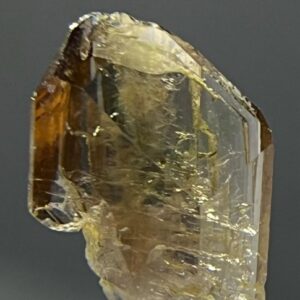High-quality Axinite is difficult to source and moderately priced at $40.00 to $165.oo per carat. Faceted stones as well as specimens will display strong pleochroism. If you’re attending a rock and gem show then you’ll probably come across more specimens than faceted stones.
As you can see from the images below, Axinite comes in brown to brownish-orange, yellow, and violet.
The main sources of high-quality Aragonite come from Arizona, California, and Tanzania.

How to determine value and cost
When determining the value of the gemstone you will be using GIA guidelines which means color, clarity, carat weight, and cut. You’ll want to look at each one of these individually and then circle back when finished to evaluate the stone as a whole.
Color is going to be the most important factor when determining the value of gemstones. Clarity and carat weight are tied for the second most important factor.
Before you go any further you need to ensure you have identified Axinite correctly.
Color – The more intense the color the more valuable the stone is. When dealing with warm colors, think of red and orange, you’ll want to determine if there are brown undertones. If you can’t see brown undertones then the color should be very vibrant. The more vibrant and saturated the color the more expensive the gemstone. If the gemstone has a unique “neon-like glow” then it will demand the highest price per carat.
With Axinite you’ll be looking for yellowish to brown-colored stones and violet-colored stones. Pleochroism will play a large role in how the colors face up (aka the color reflected back into your eye from the light entering and leaving the stone).
Clarity – Buyers, and collectors prefer stones with no internal inclusions visible to the eye. Axinite can be found with visible inclusions all the way to flawless. To determine the clarity ranking you’ll need at a minimum a 10x loop and a higher-powered microscope to confirm internally flawless and flawless designations.
If you can visibly see the inclusion while holding the gemstone then the highest designation would be SI1 and if the inclusion detracts from the overall beauty of the stone then the clarity designation would be I1 – I3.
Clarity designations – FL, IF, VVS1, VVS2, VS1, VS2, SI1, SI2, I1, I2, I3

Carat – Axinite can be found in sizes ranging from below 1 carat to above 10 carats. Generally speaking, Axinite can be sourced in most carat weights. The larger stones with high clarity will bring a higher price per carat due to rarity.
If you’re judging the value of a specimen then the weight will not matter as much as the size of the specimen.
Cut – It is sad to say but cut has the least impact on value and cost unless it affects the stone in an extreme way. For example, when you look at the stone you would be able to see through it which means light is not being reflected back to the eye. This is called a window in the stone and it would have to be quite large to impact the price. The other extreme would occur when you look at a stone and see a rough circle or oval shape inside the stone. This occurs when the stone is very shallow and it’s reflecting the rough girdle inside the stone. Note: the girdle is the edge/side of the stone where the pavilion and crown meet.

Axinite Valuations and Pricing
Small to Medium Faceted Axinite= $40.00 – $165.00 price per carat
- Only sourced from gem dealers dealing in rare gemstones
- Axinite is not rare but difficult to source faceted material

Axinite Specimens = $50.00- $500.00
- Range in size
- Sold by the gram or by the piece
- Rockhounds like these specimens because they’re really cool to look at and affordable
How valuable is Axinite?
Axinite has never brought a higher dollar per carat because the demand for this stone hasn’t taken off and the quantity of material is on the low side. Collectors and gemstone enthusiasts will buy and cut Axinite but the mass appeal for this stone will always be limited.
Values of Axinite will not increase over time
Each year I do research on market prices for Axinite and prices for small to mid-sized stones are fairly constant. If I was looking to add Axinite to my collection then I would try to source crystal clusters with larger crystals mixed in with smaller crystals.
If you’re not sure how to value a gemstone then you should consider a gemstone appraisal. Individuals acquiring gemstones through inheritance, estate sales, and auctions typically have the gemstone appraised to determine the value and to ensure the gem is what they think it is.
- Identify Enstatite - March 12, 2024
- Identify Cerussite - March 3, 2024
- Identify Bytownite - February 18, 2024
